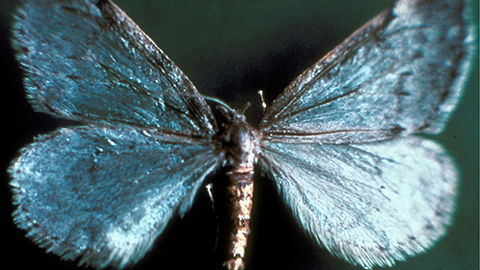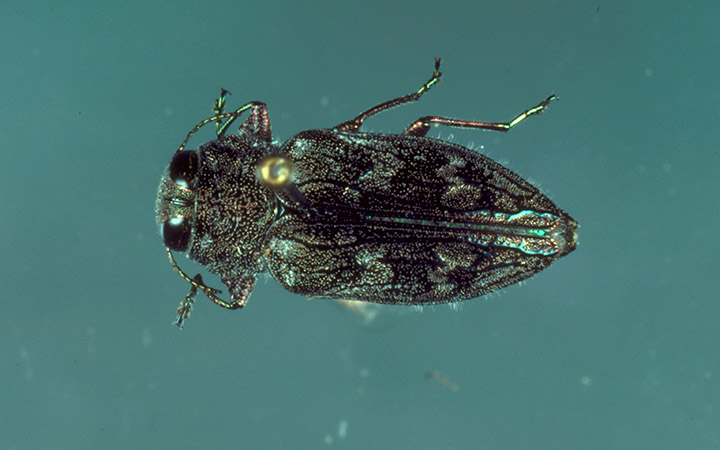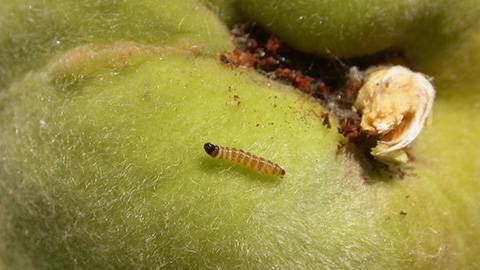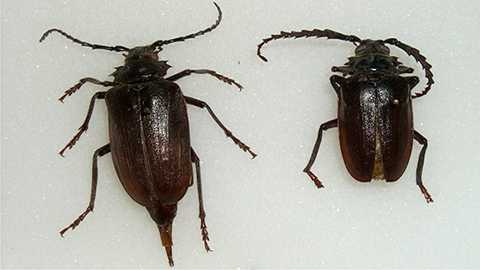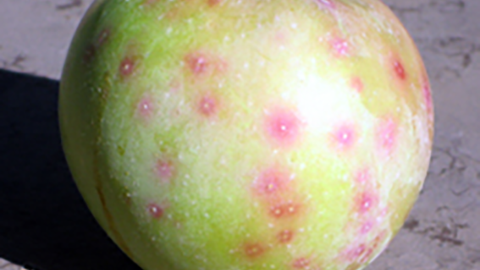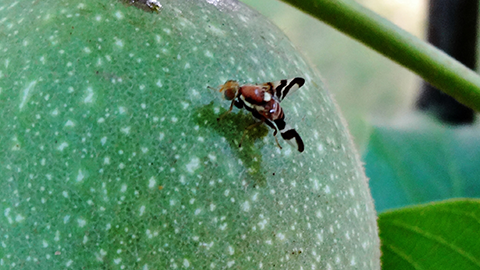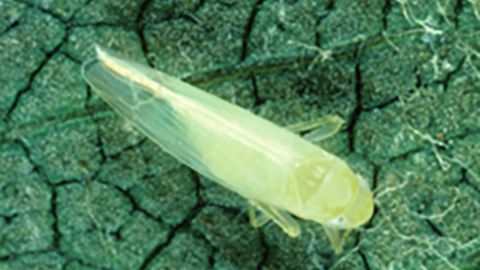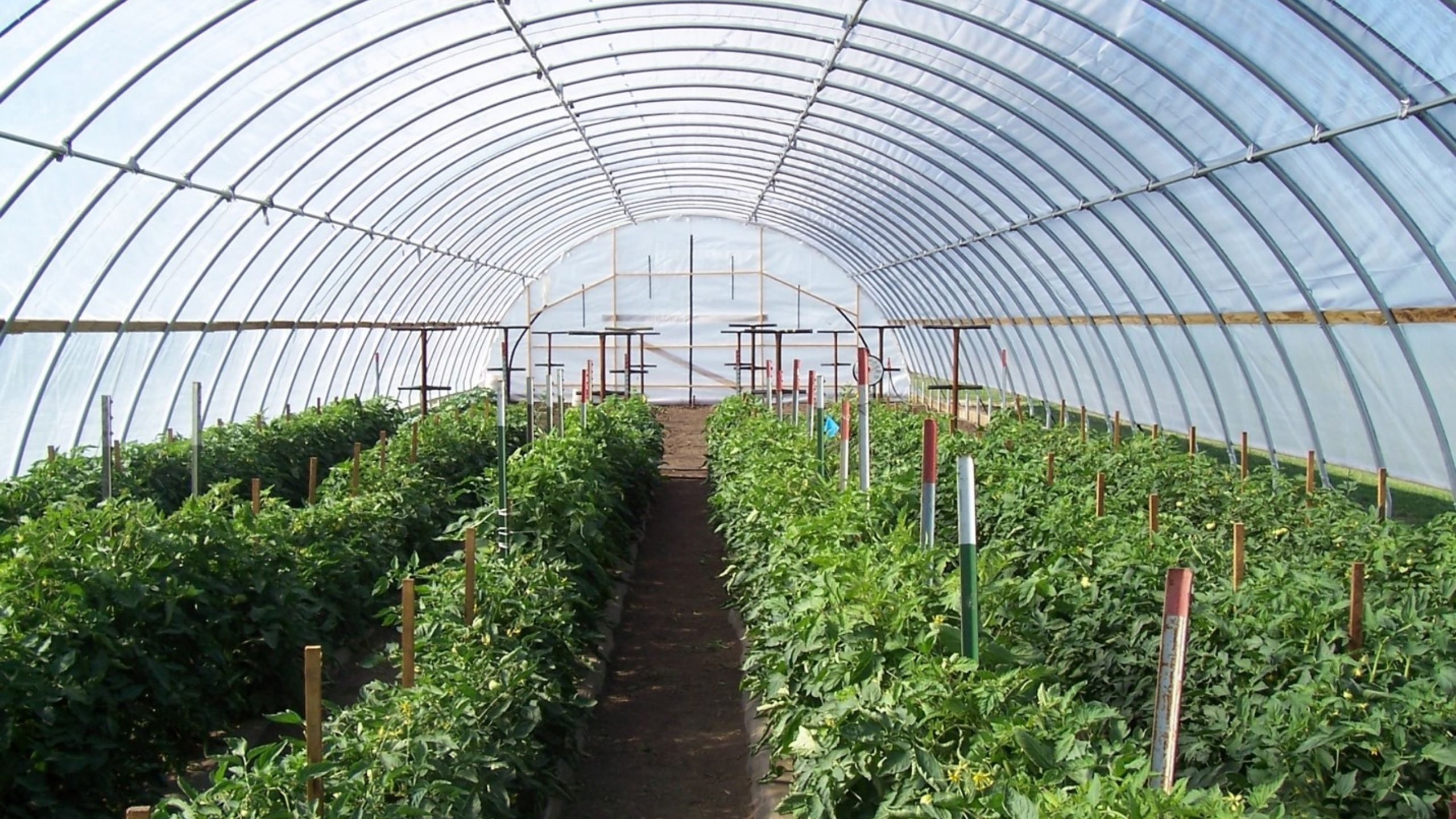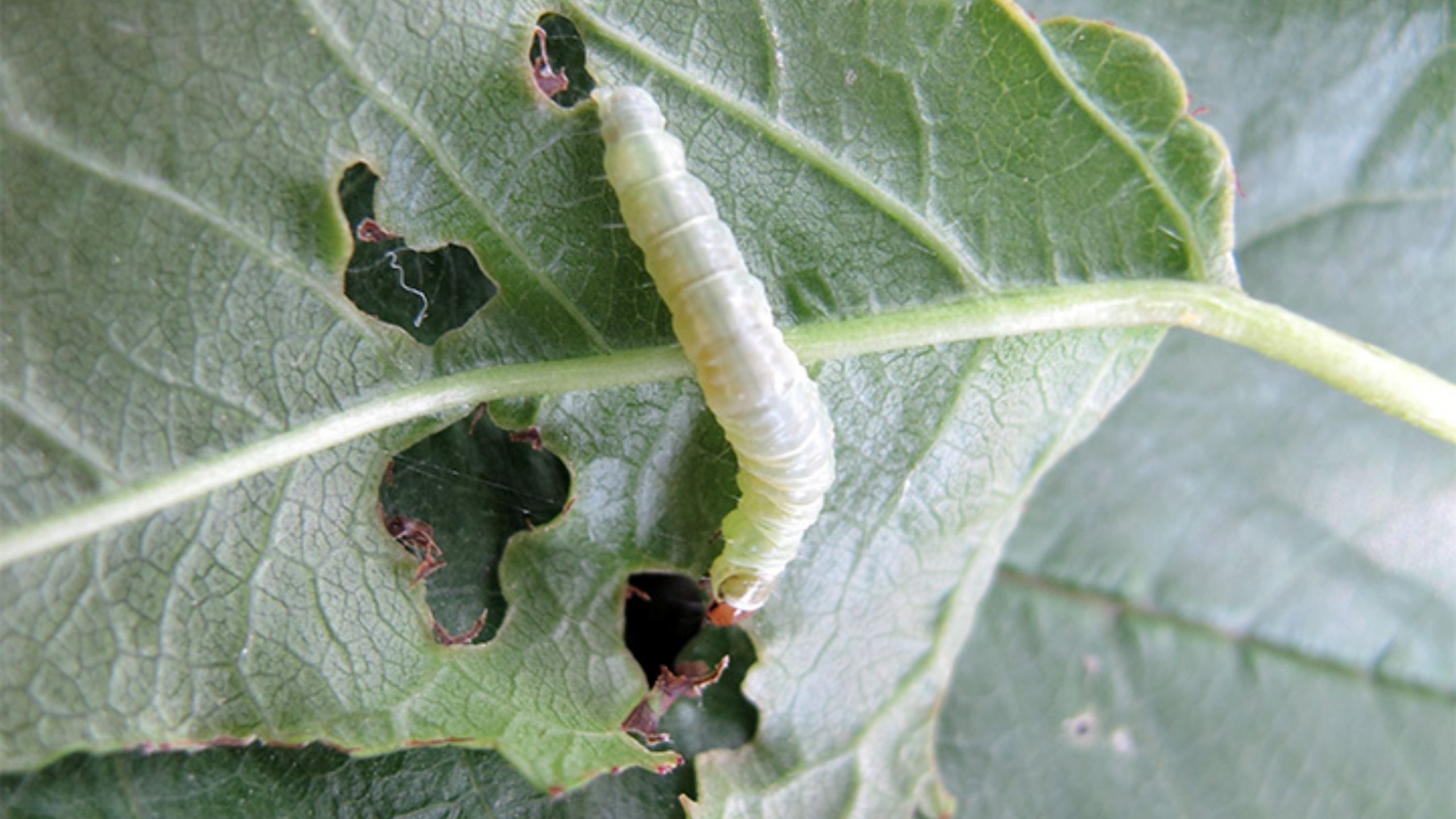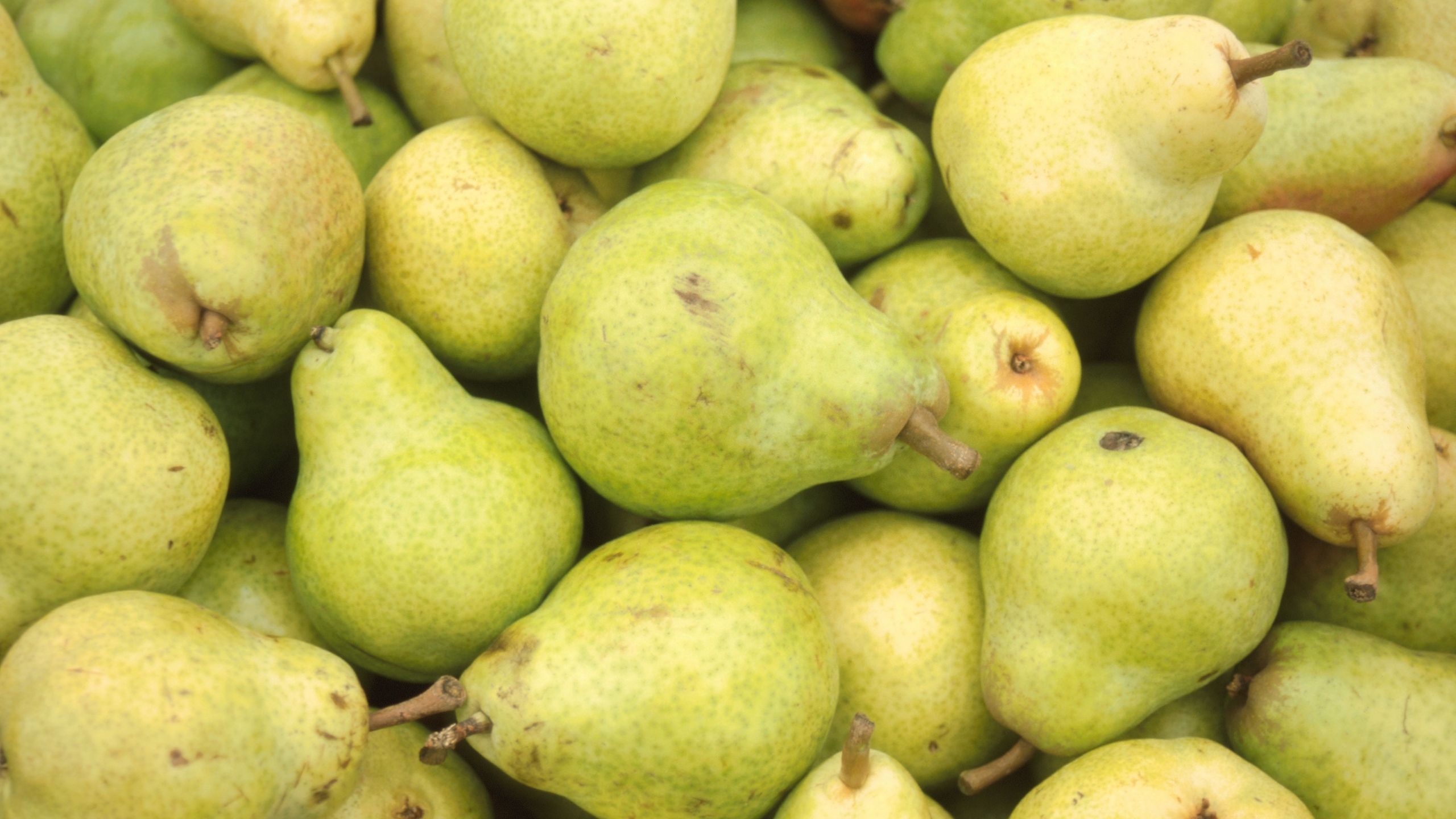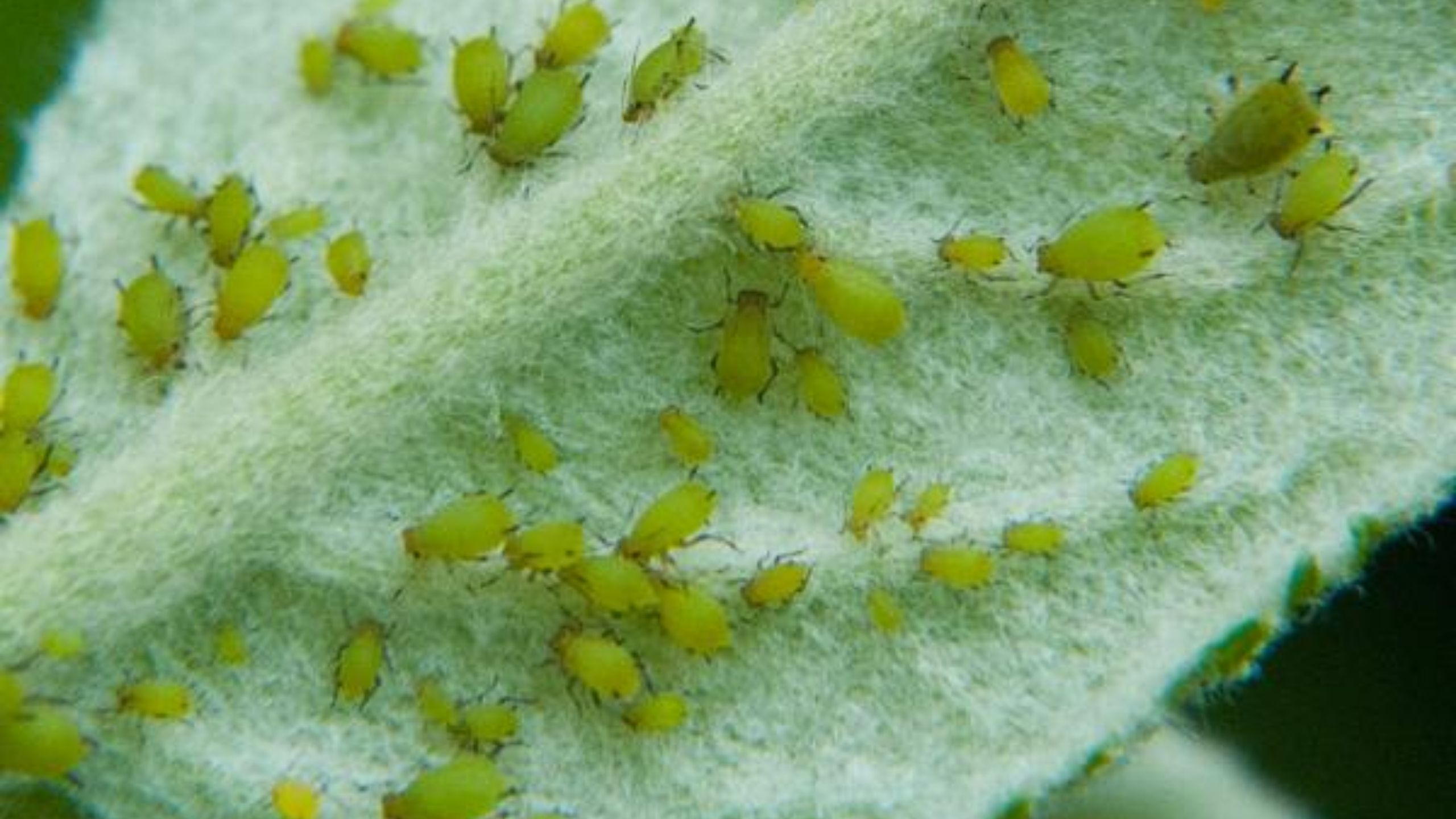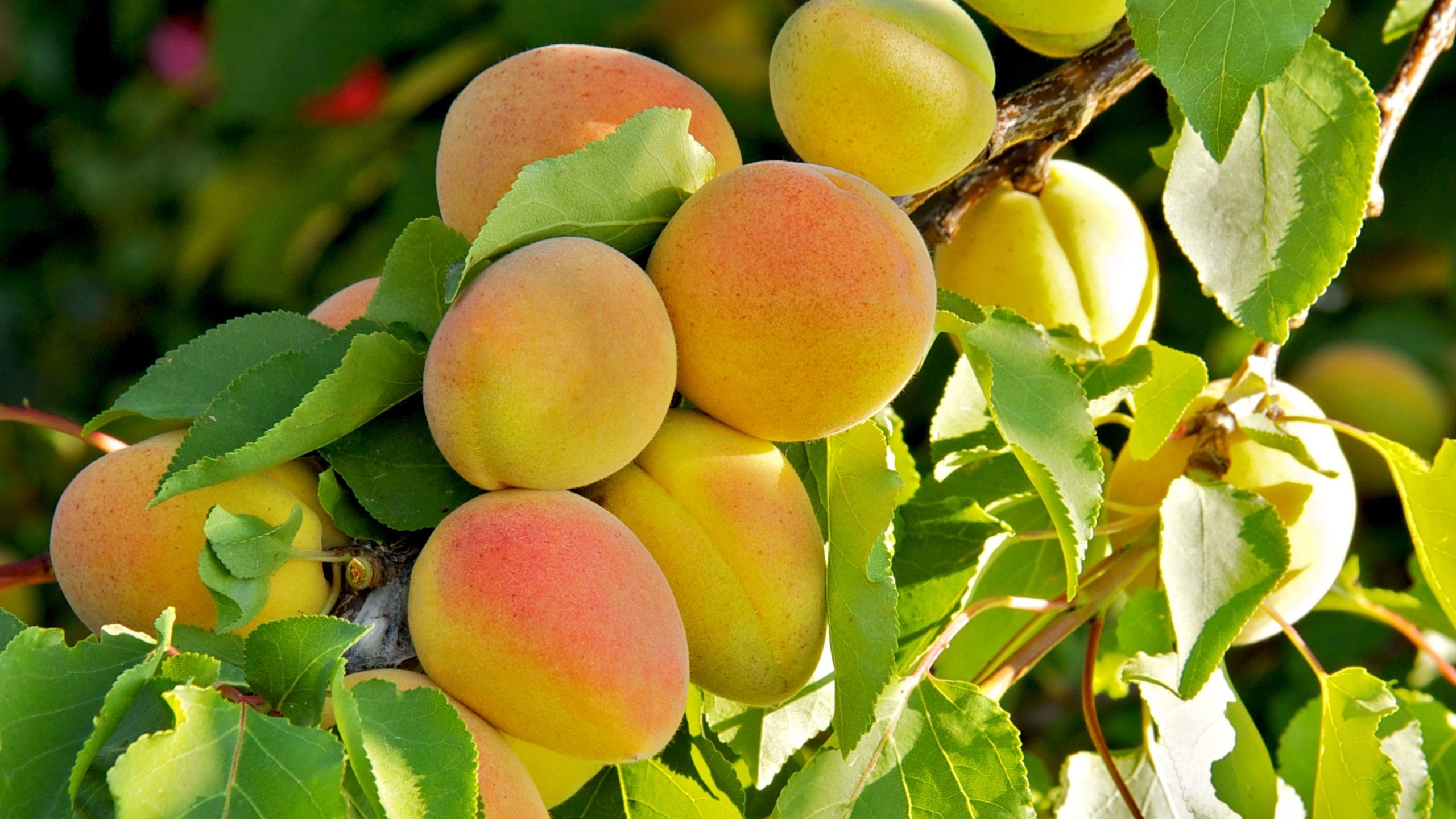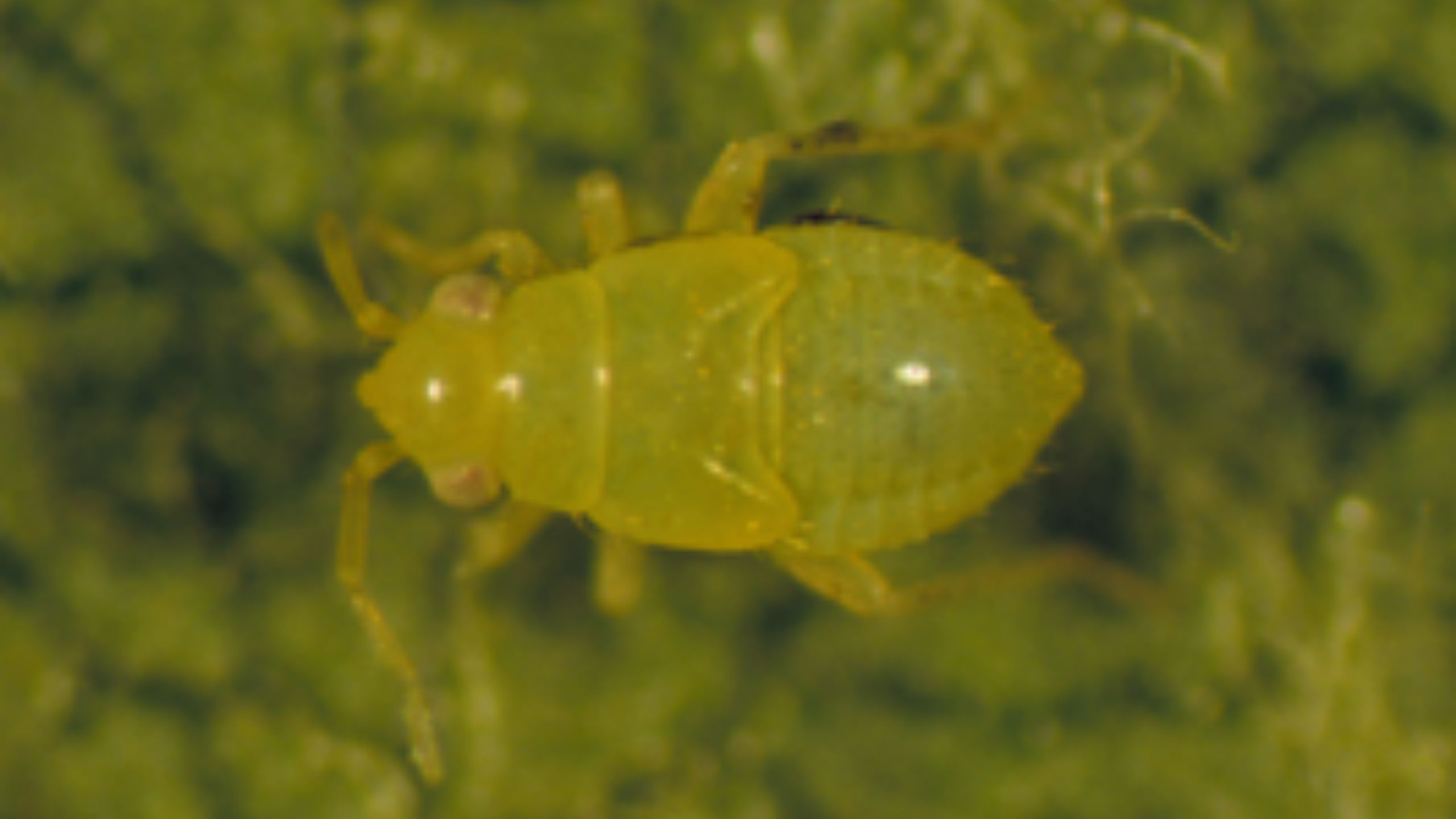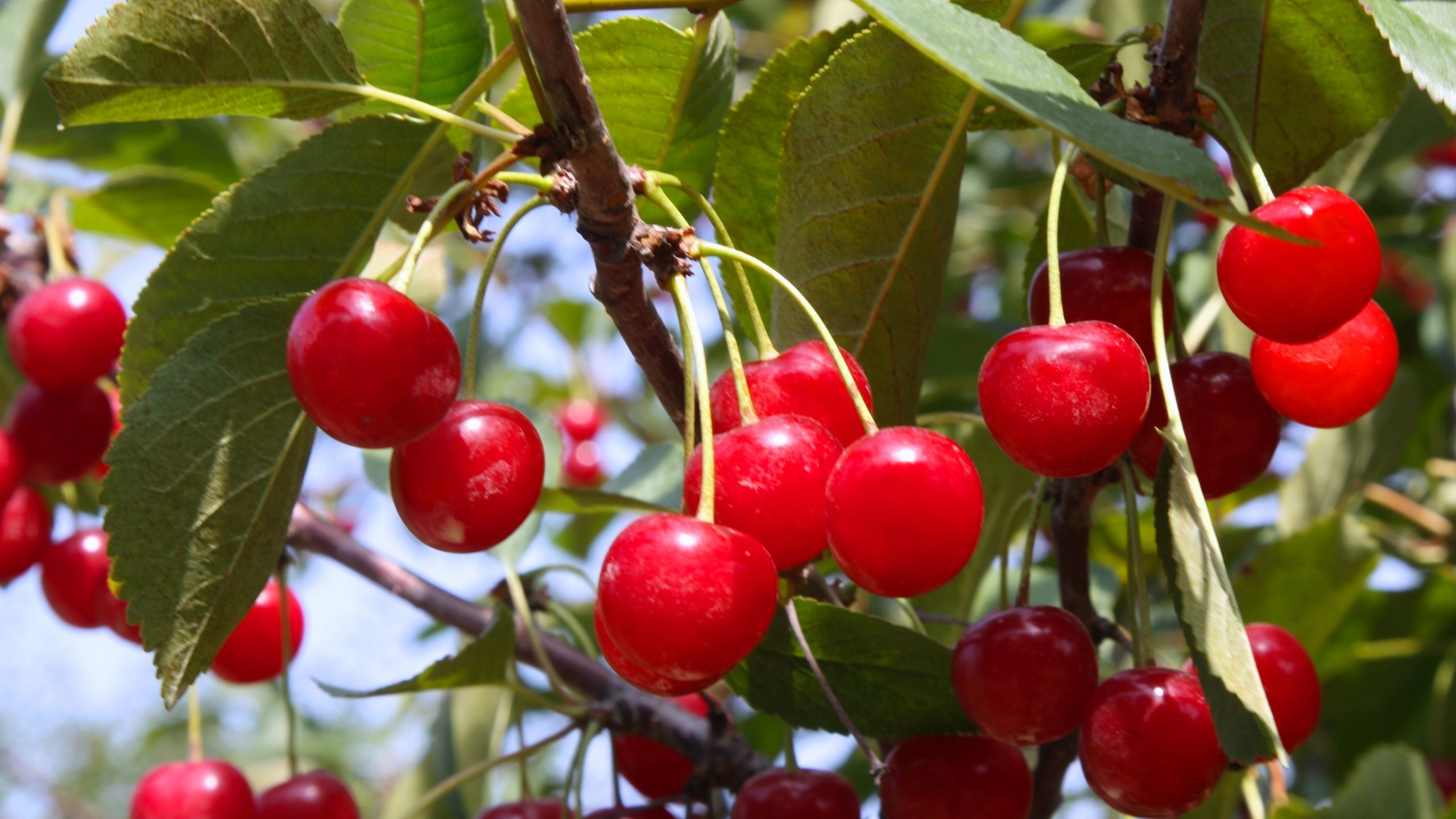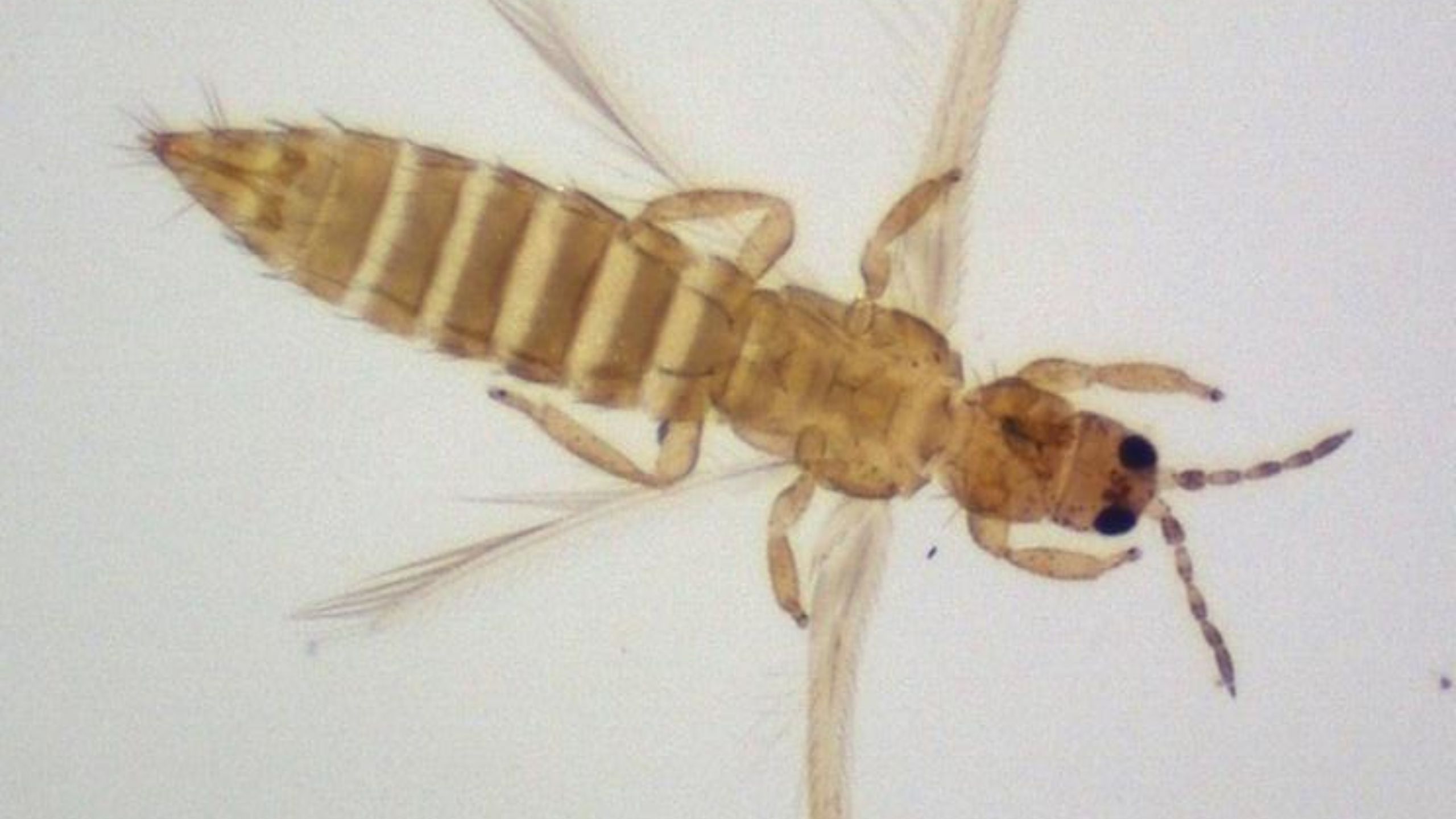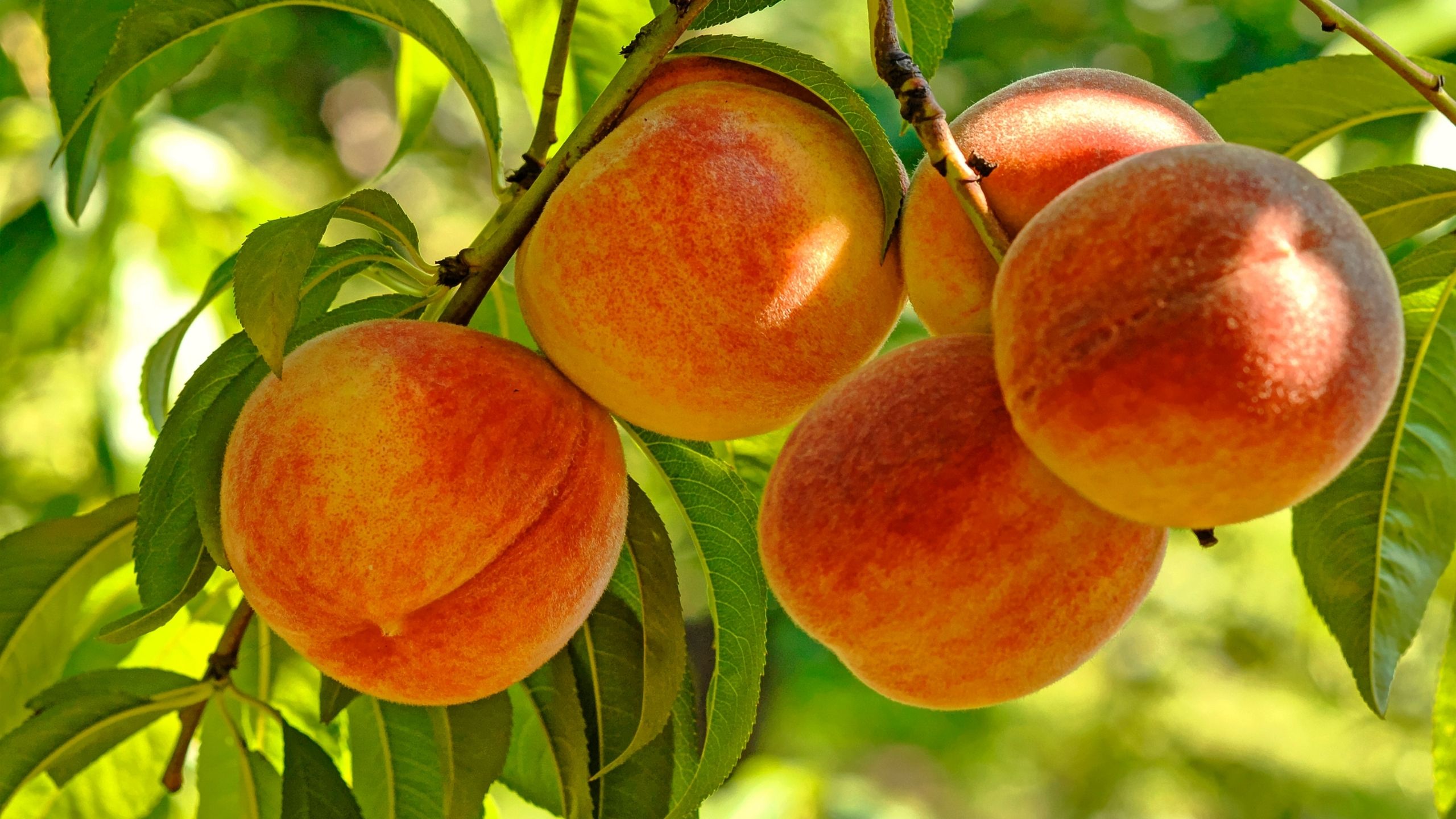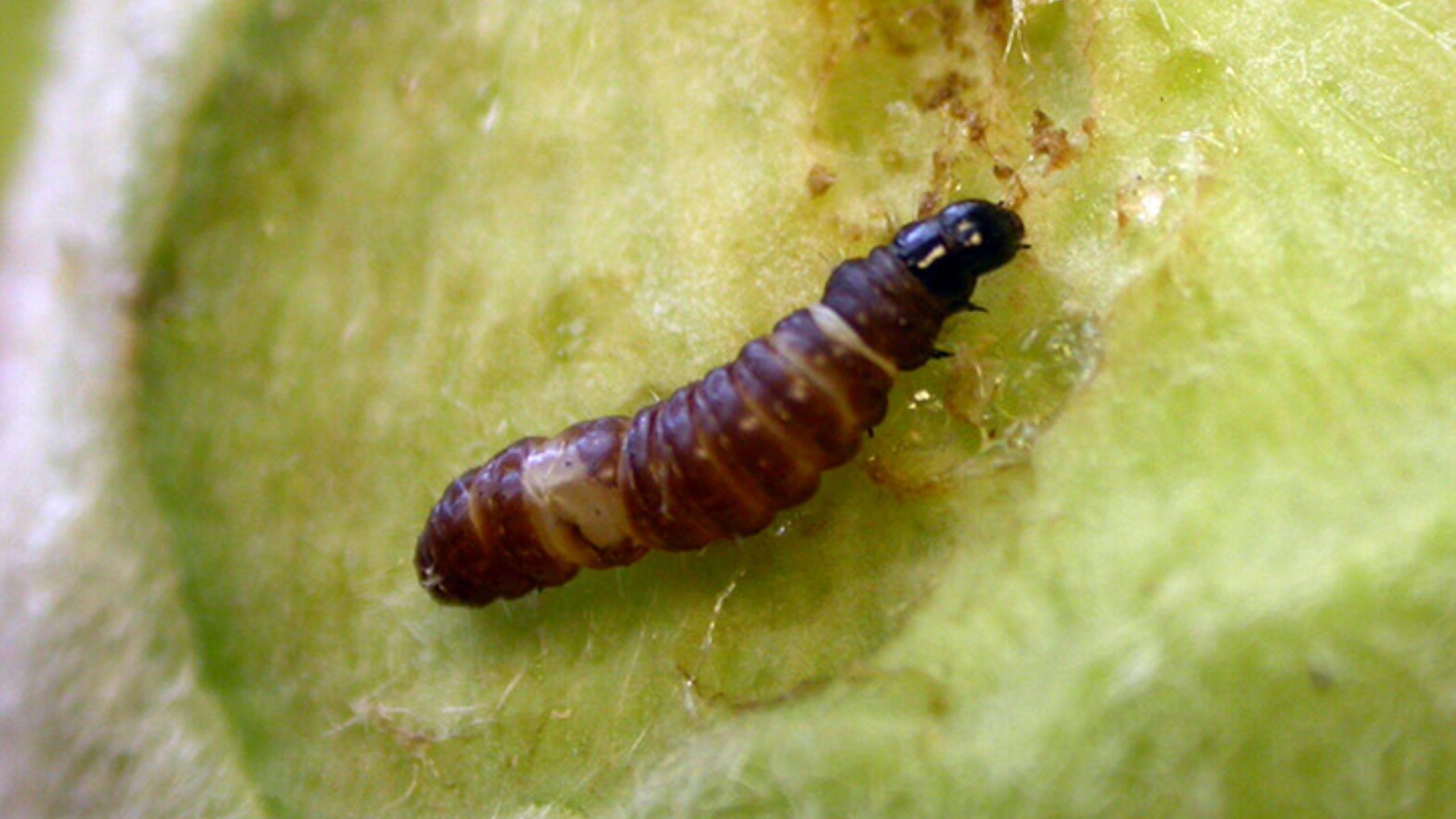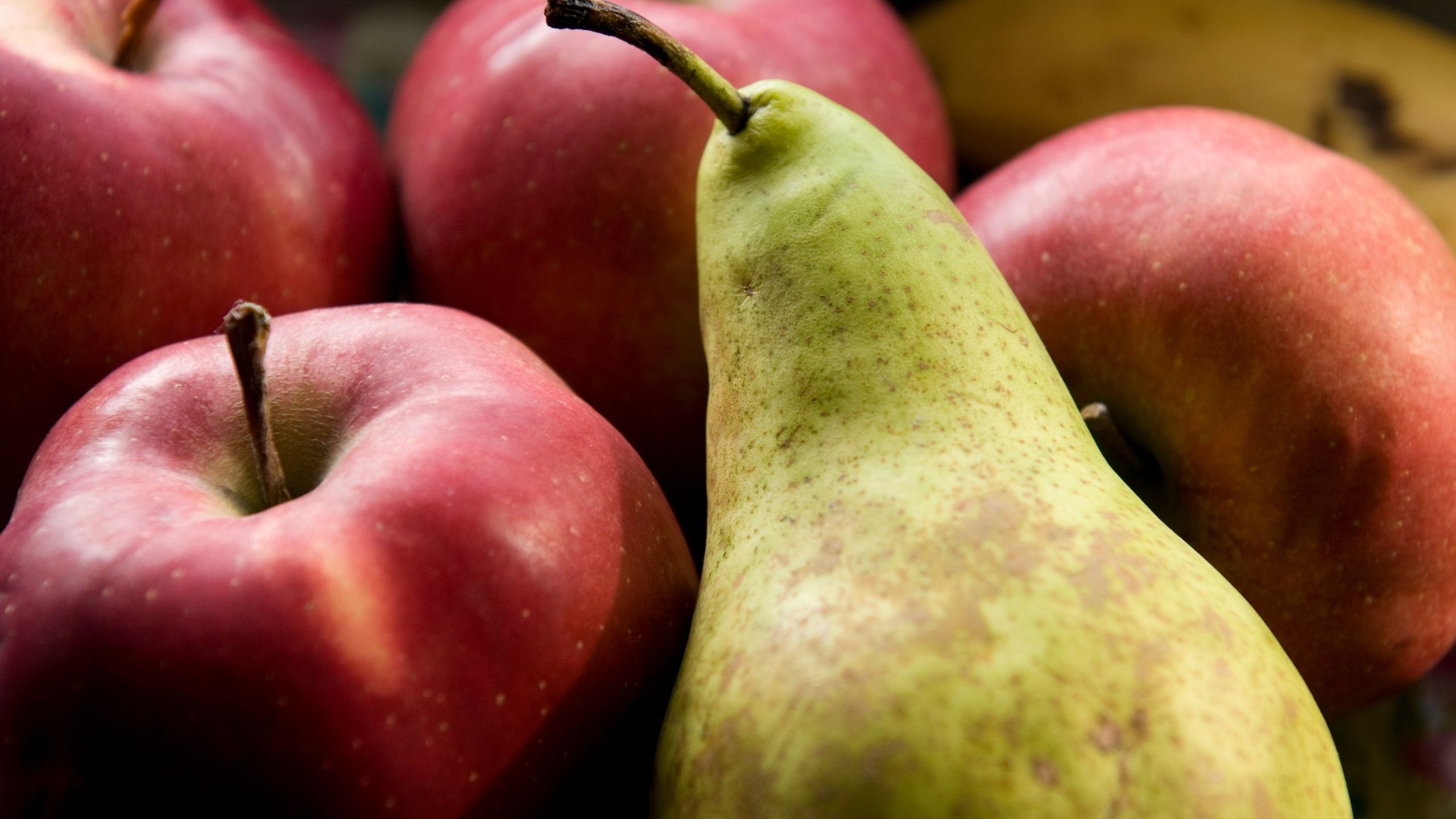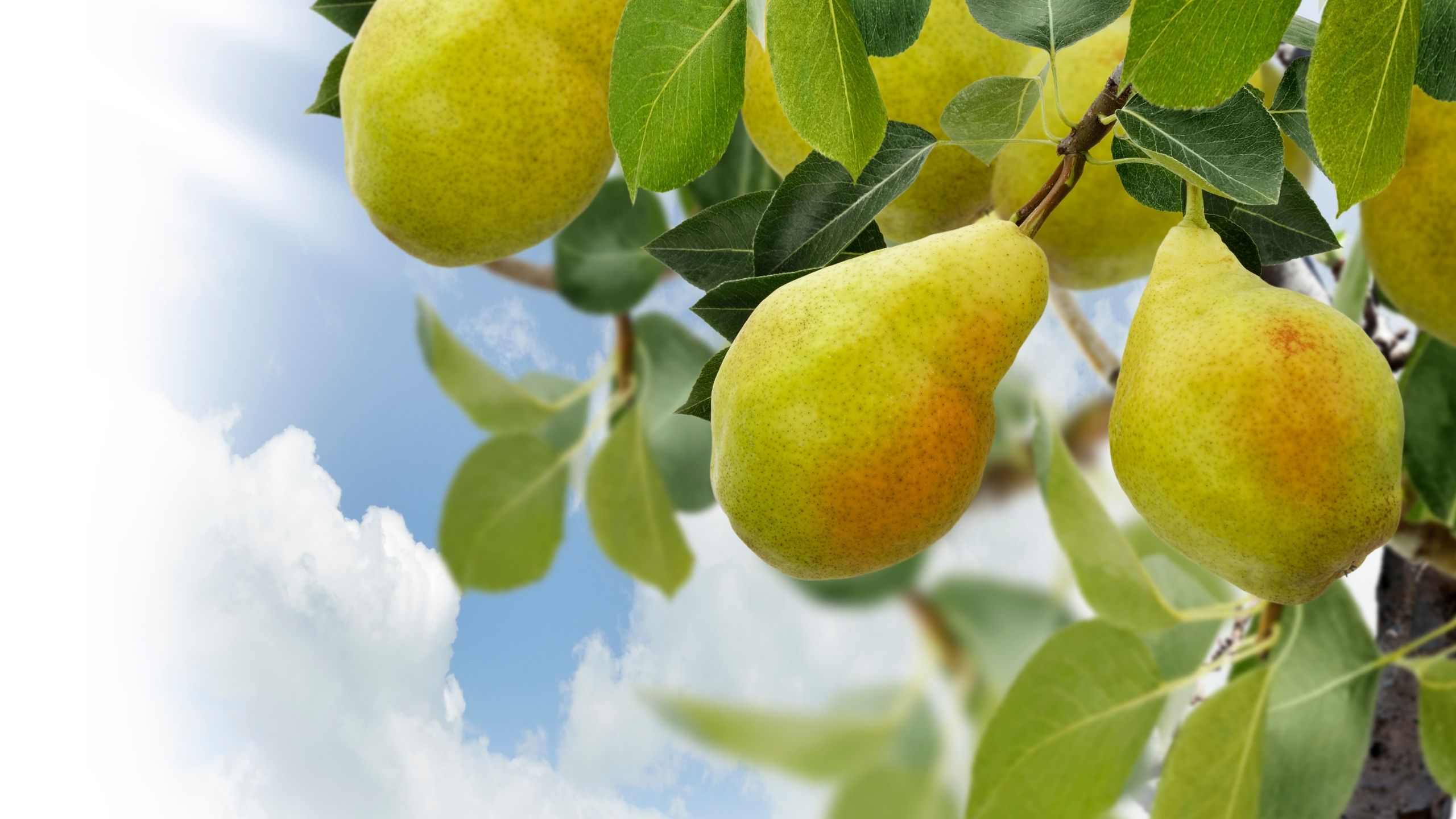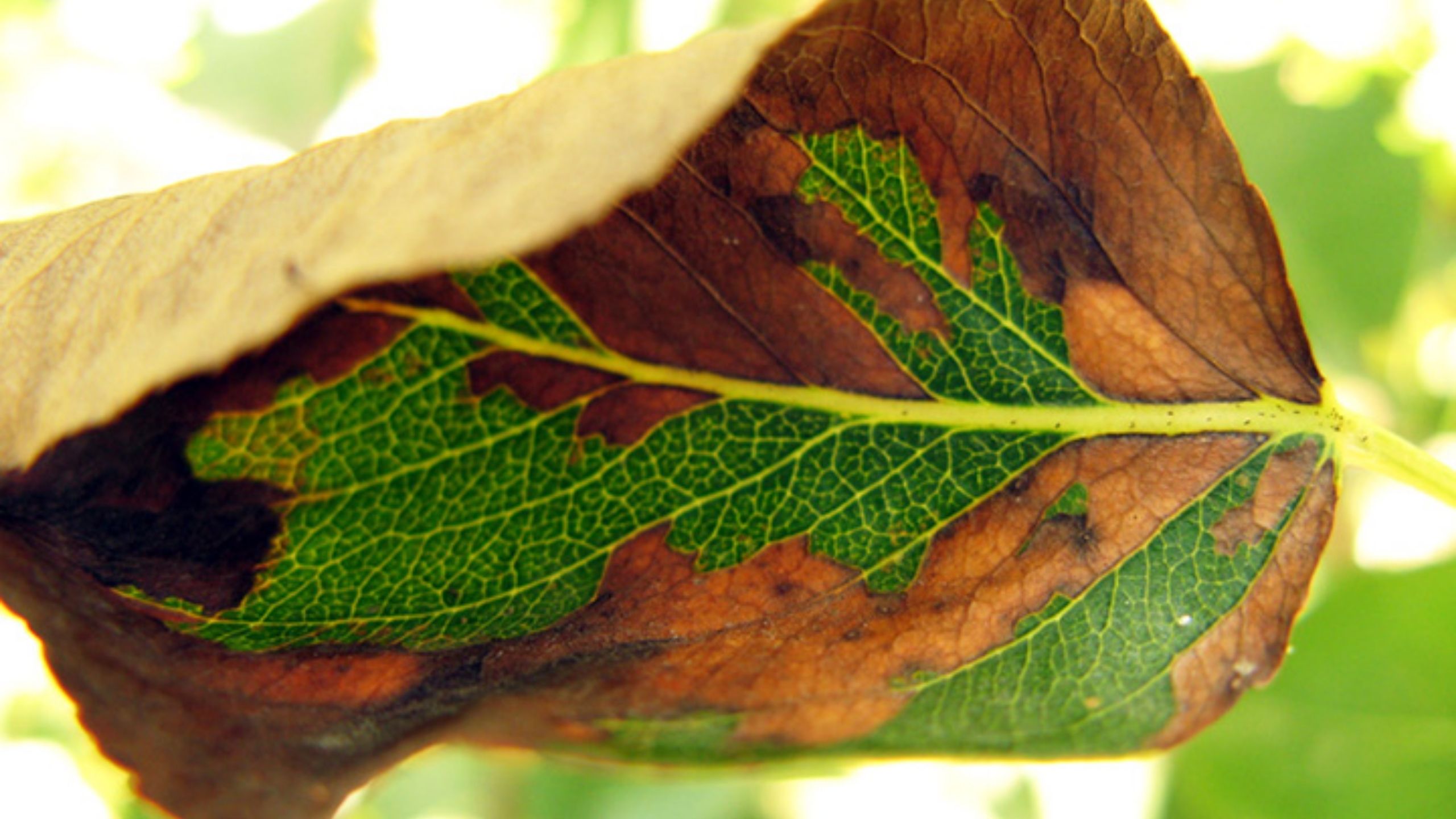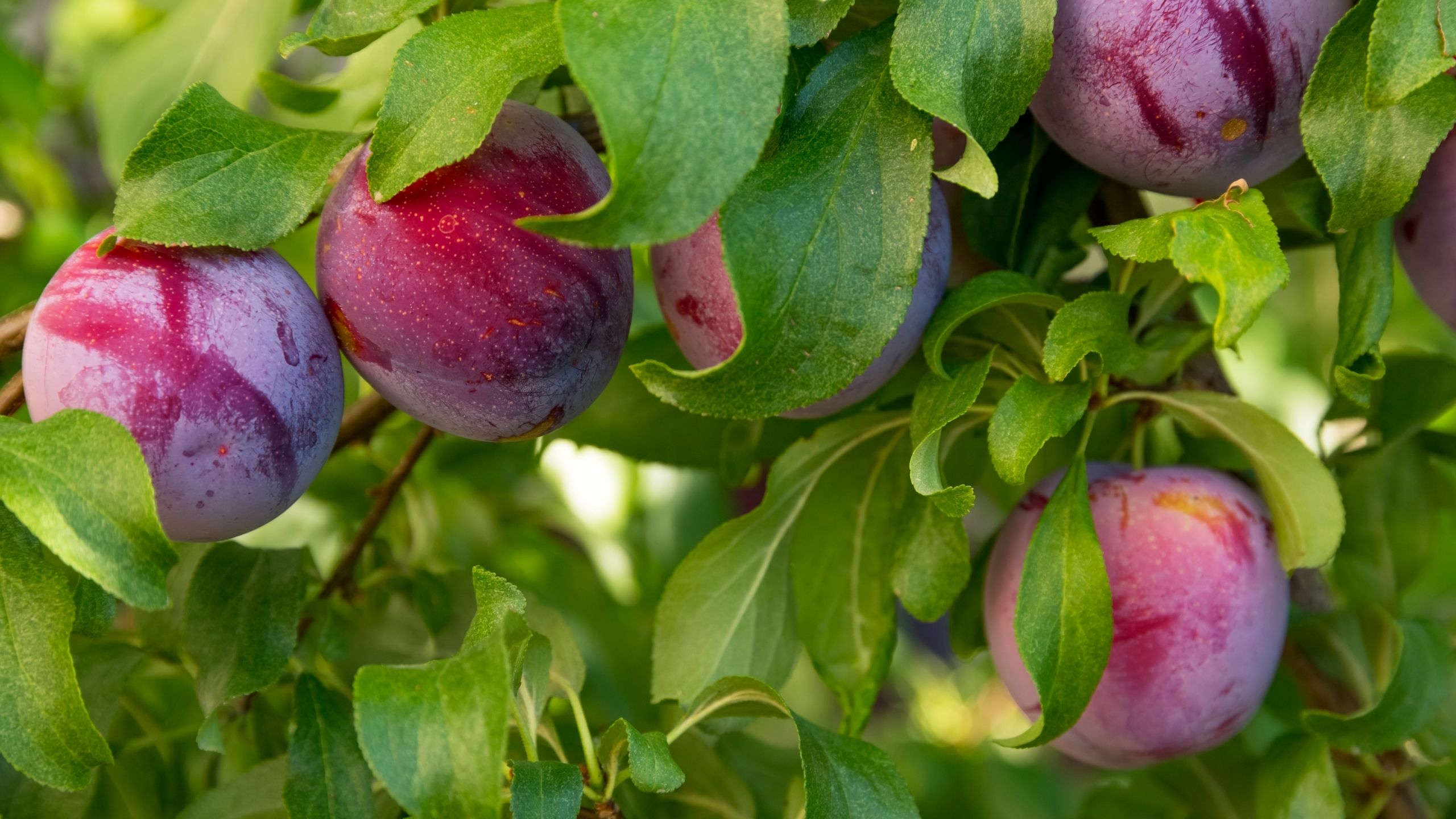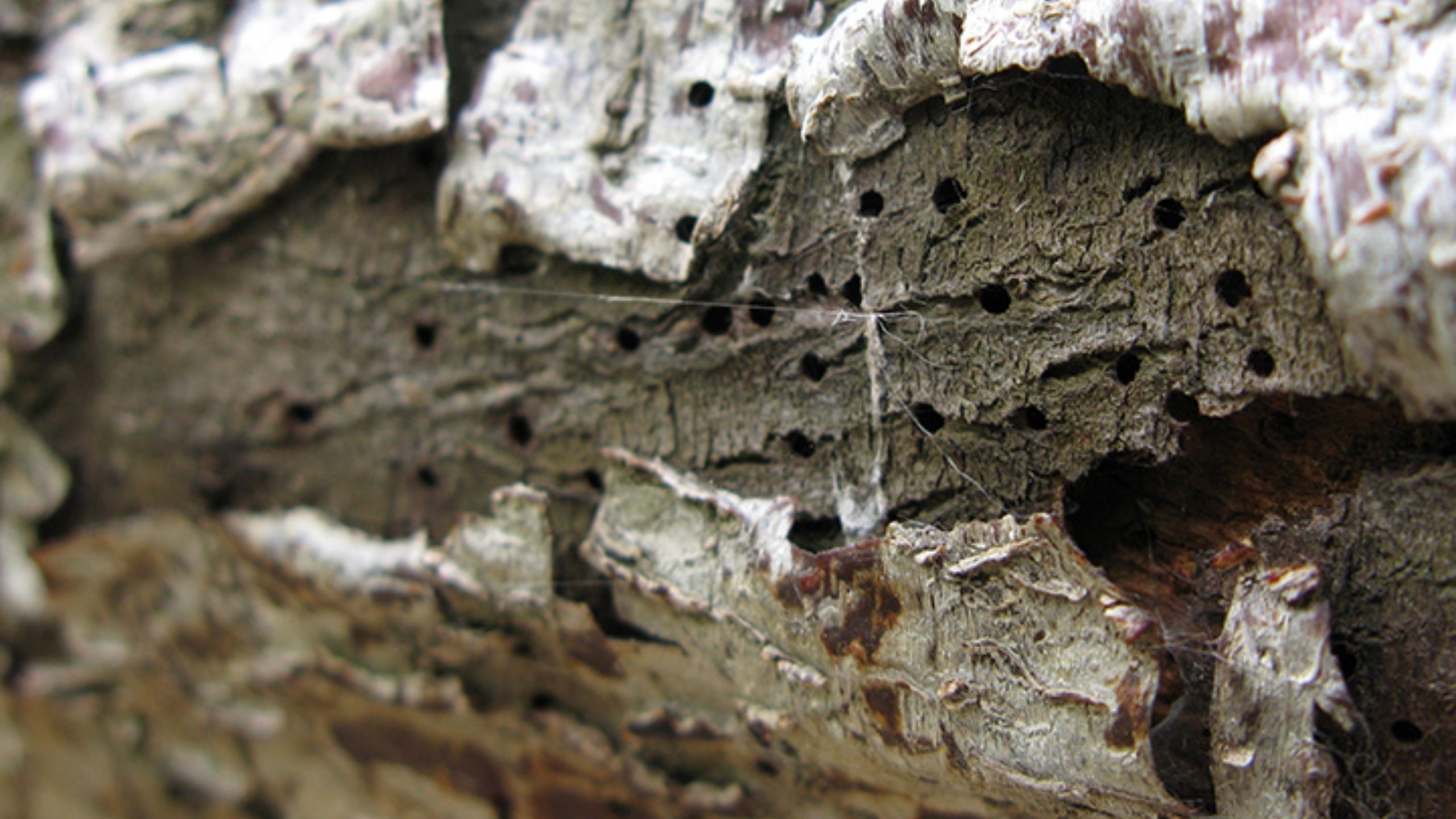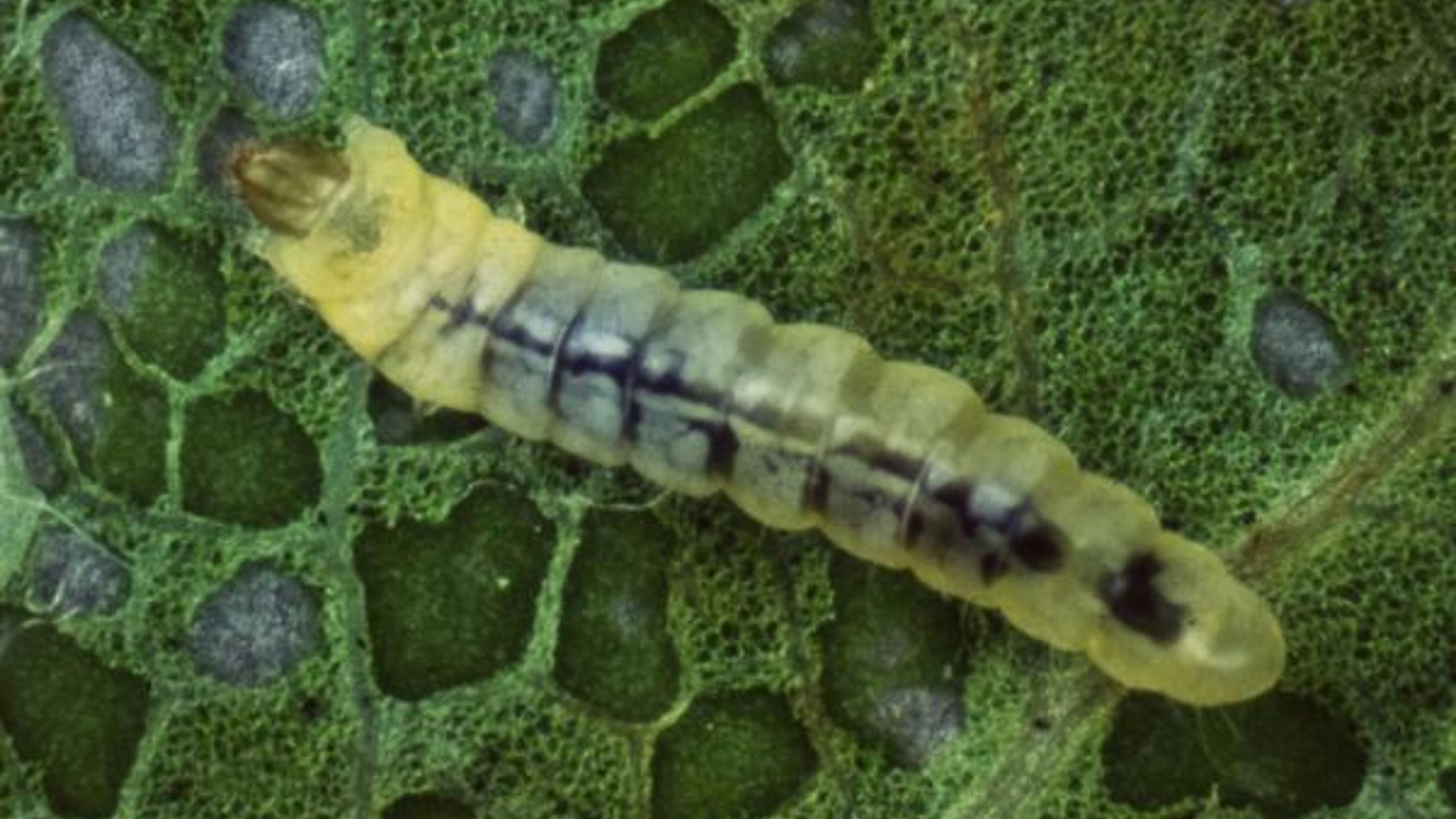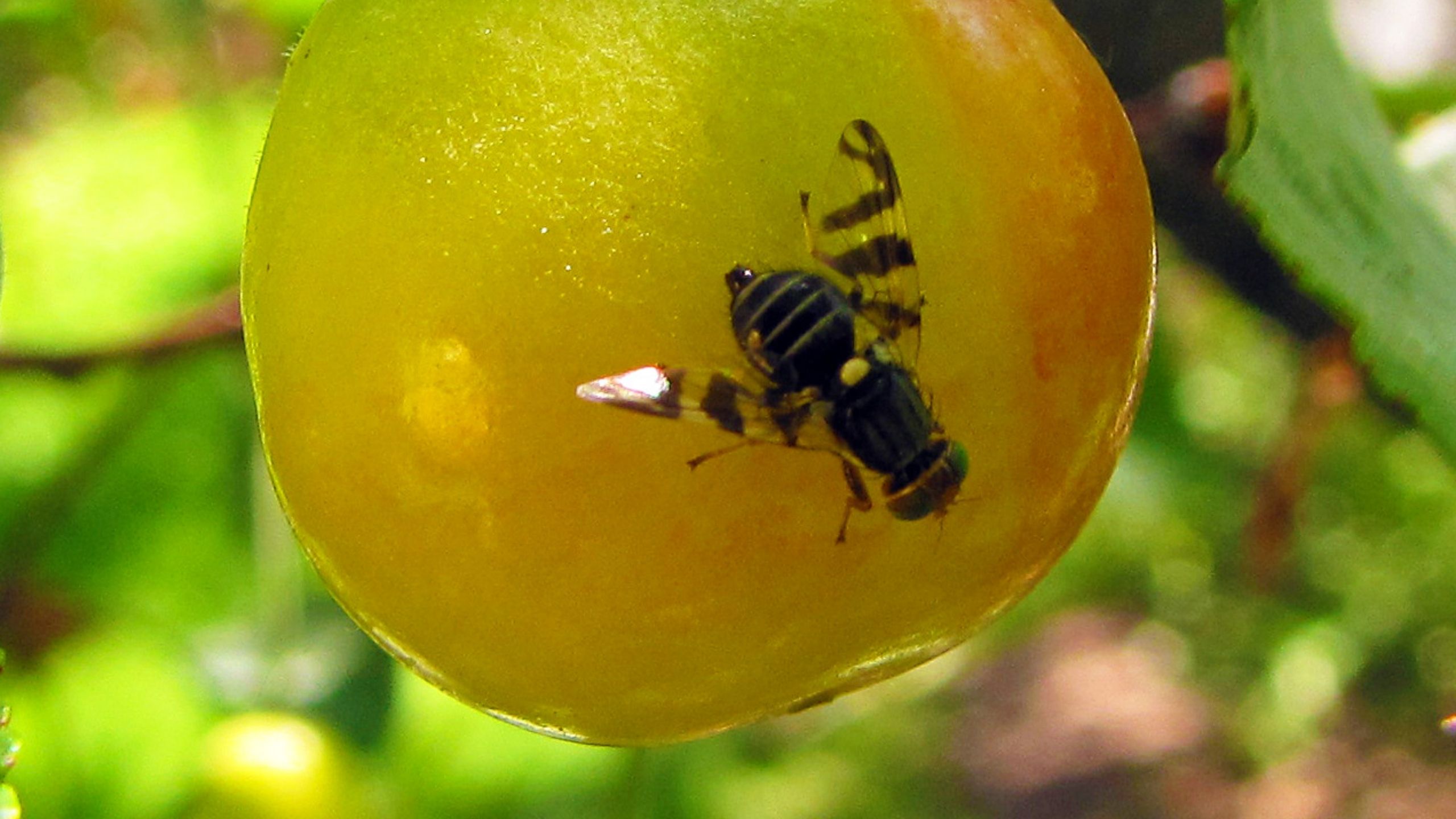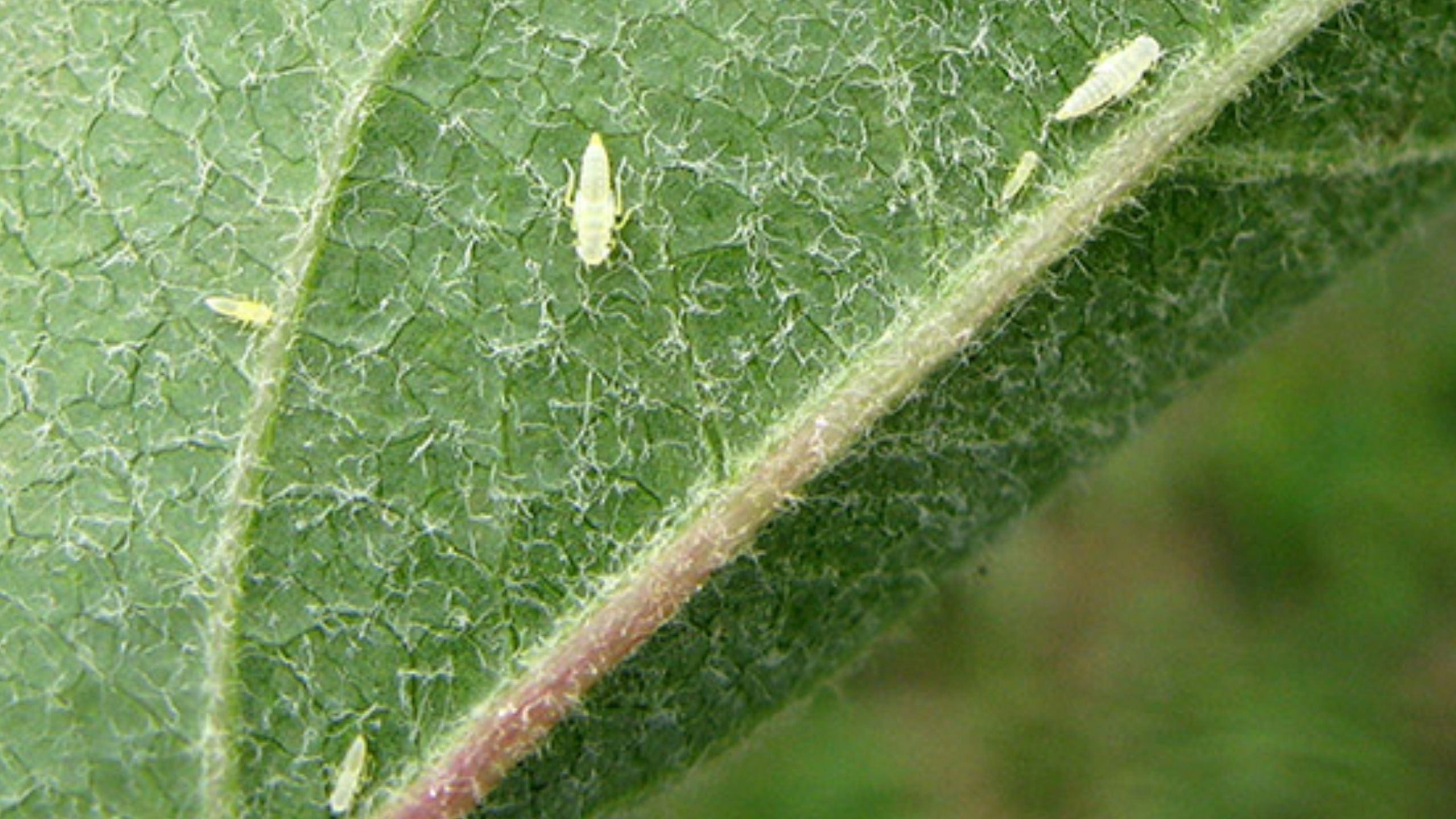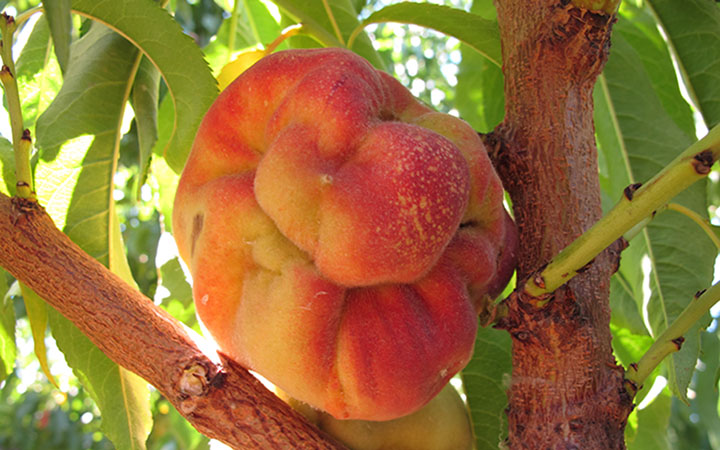European Red Mite
(Panonychus ulmi)
October 2011
Diane Alston, Entomologist (No longer at USU) • Michael Reding, Entomologist (No longer at USU) • Marion Murray, IPM Project Leader

The female European red mite has a red body with white legs and hairs and spots on her back. Image courtesy of E. Beers, Washington State University.

The male is yellow and green-black with a tapered hind end. Image courtesy of B. Croft.
Quick Facts
- European red mite infestations are sporadic in Utah orchards, but injury can be severe when populations are high.
- Adult and immature mites feed on leaves causing white stippling, bronzing, and defoliation.
- Tree vigor and fruit color, size, and production can be reduced.
- If the mite is present, the most effective control is a delayed dormant oil spray applied as overwintering eggs begin to hatch.
- If active mite stages persist following bloom, early summer treatment is recommended based on presence-absence sampling.
The European red mite is native to Europe and was first introduced into the Pacific Northwest in the early 1900s. Since then, it has spread and become established throughout the United States and Canada.
Mites are tiny arthropods, measuring less than 1/60 inch (0.42 mm) that are closely related to ticks and spiders. The European red mite belongs to a group of plant-feeding mites, called spider mites (Order Acari, Family Tetranychidae), which includes the twospotted and McDaniel spider mites. However, unlike its cousins, the European red mite does not spin copious amounts of webbing.
European red mite also has a more limited host range than the twospotted and McDaniel spider mites. It attacks many crops and ornamentals but is limited to perennial trees and shrubs. Infestations of European red mite are somewhat sporadic in Utah orchards; however, infestations can be severe and cause substantial crop and tree injury. Unlike twospotted and McDaniel spider mites, the European red mite overwinters on tree limbs in the egg stage. Therefore, its management is considerably different from that of webspinning spider mites.
Flare-ups of European red mites are often associated with improper pest management and pesticide application practices. The red mite has a long history of developing resistance to miticides, but that is usually not a problem in orchards with a low toxicity or soft pesticide program. In Utah, European red mite populations tend to peak during early summer if a delayed dormant oil spray was missed, or if other factors cause high mite populations in the orchard. Populations then subside somewhat during the hottest mid-summer months, but they may peak again in late summer to early fall if biological control agents are not established to suppress them. There can be from five to eight overlapping generations per year.
Plant Hosts
European red mite is a pest of pome and stone fruits, nuts, berries, and some ornamental trees and shrubs. Apple and pear cultivars vary in their susceptibility to mite injury. The highest red mite populations are typically seen on Red Delicious and Rome apples. Although spider mite injury to pear is more commonly caused by the twospotted or McDaniel spider mite, when injury from red mite does occur, it is usually more severe on pear than apple.
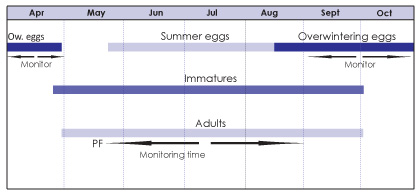
The long arrow represents times when immatures and adults should be monitored (PF = petal fall). Overwintering eggs can be monitored from fall through early spring (short arrows).
- Apple
- Cherry
- Cane and bramble berries
- Peach
- Pear
- Plum
- Some ornamental trees and shrubs
Life History
Egg-Overwintering Stage
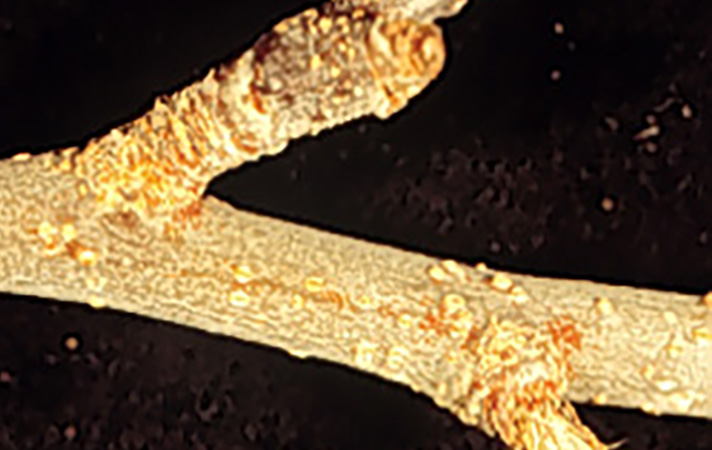
Overwintering eggs look like paprika sprinkled on twigs, buds, and spurs.

Eggs are spherical with a slender stalk on top. Image courtesy of E. Beers, Washington State University.
- Size, color, and shape: 1/160 inch (0.16 mm) in diameter, dark red, and spherical with small ridges running top to bottom and a slender tassel or stalk.
- Where: overwintering eggs are found on rough bark at the bases of buds and spurs, on small limbs and twigs, and in limb crevices and forks; summer eggs are found along leaf veins predominantly on the undersides of leaves and sometimes on fruit if populations are high.
- When: overwintering eggs are deposited during August and September and hatch the following spring between tight cluster and bloom; summer eggs hatch throughout the summer.
Immature-Damaging Stage
There are three forms of immatures—larva, protonymph, and deutonymph—with a molt between each stage. A molt is where the cuticle or “skin” is shed. Each molt is preceded by a resting period during which the immature mite stops feeding and the body appears silvery.
Larva
- Size, color, and shape: slightly larger than the egg, orange red, and has three pairs of legs
- Moves to young leaves and begins feeding, usually on the undersides
Protonymph and Deutonymph
- Size, color, and shape: gradually larger, red, and have four pairs of legs; greenish red just after molting, turning bright red as feeding resumes.
- Sex is distinguished at the deutonymphal stage as females grow larger and more oval than males.
- Feed on the undersides of leaves.
Adult-Damaging Stage
- Size, color, and shape: female is about 1/72 inch (0.35 mm) long, brick red, and oval shaped with white hairs on her back and white spots at the base of the hairs; male is 1/80 inch (0.32 mm) long, red tinged with yellow, and more slender and tapered near the hind end.
- Where: feeds mainly on the undersides of leaves; moves to upper leaf and fruit surfaces when populations are high
- When: first appears around petal fall and mates immediately.
- Female begins laying eggs after two days; lives up to 20 days and lays an average of 30 to 35 eggs.
- One generation can be completed in 10 to 25 days, depending on the temperature; typically there are five to eight overlapping generations per year.
- Adults will “balloon” in order to disperse when densities are high by crawling to a high point, rearing up on their hind legs, and catching a wind current to balloon on a silken thread.
Nymph-Damaging Stage
- Size, color, and shape: smaller than the adult, pale green, but has no wings.
- Passes through five instars.
- Distinct spots appear on the thorax and abdomen, and developing wing pads are obvious during instars three through five.
- Feeds on plants by piercing the tissue and sucking the juice.
- May not cause damage to tree fruit crops, but nymphs do damage other crops.
HOST INJURY
Mites feed by piercing leaf tissue with their mouth parts and sucking out the cellular contents. Fruit trees and cultivars differ in their susceptibility to mite damage. Pear is most sensitive to mite feeding, then stone fruit. Apple is the most tolerant. The effects of mite feeding on trees accumulate over time.
Pear
- Feeding causes leaves to lighten and become mottled or stippled.
- Heavy feeding can cause severe injury, such as necrosis, leaf burn, and defoliation.
- Leaf burn can even occur after mites have been controlled if high temperatures follow feeding damage.
- Severe damage and defoliation can cause a reduction in fruit size and return crop load.
- Red strains of pear cultivars are more tolerant to mite injury than green strains; Bartlett and Comice are more tolerant to leaf burn and defoliation than D’Anjou and Bosc.

Feeding injury by European red mite to apple leaves on the right. Image courtesy of L. Hull, Pennsylvania State University.
Apple
- Red Delicious usually has higher red mite populations, but Golden Delicious is more susceptible to damage.
- Feeding causes white stippling on leaves that can eventually turn brown, called bronzing.
- High populations can cause defoliation.
- The following year’s crop may be reduced in both fruit size and amount of fruit.
- Eggs may be deposited on the calyx end of fruit, causing downgrading and processing problems.
Stone Fruits
- Injury is intermediate compared to pear and apple.
- Light infestations cause leaf speckling.
- Heavy infestations can cause the following: bronzed and pale leaves; undersized and poor quality fruit; reduced tree vigor; and decreased yield the year after significant June and July infestations because fewer fruit buds are formed.
- Extremely heavy infestations can cause leaf drop and tree stress which can lead to reduced winter hardiness.
Timing Control
Because mites may be feeding on trees from the pre-bloom stage through fall, it is important to continually monitor for mites. Mites can build up at different times and in different blocks or years. Therefore, make sure to not only consider the mite density at one point in time, but to also monitor densities over a period of time and use this information to assist with control decisions.
Delayed Dormant
The most effective and easiest time to control the European red mite on all types of fruit trees is during the delayed dormant period (half-inch green to tight cluster) before overwintering eggs on the limbs begin to hatch.
- Carefully scout orchards from late fall through early spring for the tiny, bright red eggs on small limbs and twigs near buds and spurs.
- Scouting for overwintering eggs is especially important if European red mite was detected the previous season.
- Large numbers of overwintering eggs may look like paprika sprinkled on tree limbs.
- Reddish stains on the fingers after handling infested limbs, or leaves later in the season, indicate the presence of European red mite.
Post Bloom
- Immatures and adults should be monitored beginning at petal fall to determine if early summer miticide treatments are necessary; keep in mind that there may be a lag time in buildup of predator populations.
- A reliable and easy-to-use sampling method for all spider mites is the presence-absence, or binomial, method; this method requires the scout to determine only the proportion of infested leaves and does not require a count of individual mite numbers; refer to the bulletin on “Web Spinning Spider Mites” for a complete description of how to sample.
- Use the European red mite look-up table (see Table1) to estimate the number of mites per leaf.
- Use the “Spider and Predatory Mites Sampling Form” to record the number of infested leaves during sampling.
Management
Delayed Dormant
If overwintered eggs are present, apply a delayed dormant oil spray (half-inch green to tight cluster). This treatment is the most important management tactic for the European red mite. Eggs are most vulnerable to control just before hatching. If a delayed dormant spray is missed, later sprays may be required to keep European red mite populations below damaging levels. This may result in the destruction of beneficial predatory mites and insects and the outbreak of secondary pests, such as twospotted and McDaniel spider mites. Although a delayed dormant spray may not provide season-long control, it can prevent early summer buildup of the mite.
Recommended chemical:
- Dormant horticultural oil (superior, supreme, or other oil designed to be applied during the dormant season)
Table 1. European red mite presence-absence sampling look-up table
| Number of leaves out of 10 with at least one mite present* | Apple and Pear Estimated number of European red mites per leaf on apple and pear |
Cherry and Peach Estimated number of European red mites per leaf on cherry and peach |
| 1 | 0.1 | 0.1 |
| 2 | 0.3 | 0.3 |
| 3 | 0.5 | 0.7 |
| 4 | 0.8 | 1.1 |
| 5 | 1.2 | 1.7 |
| 6 | 1.8 | 2.4 |
| 7 | 2.5 | 3.5 |
| 8 | 3.5 | 5.3 |
| 9 | 5.7 | 8.7 |
| 10 | -- | -- |
Post Bloom
If European red mites are present later in the season, the grower will need to make a decision about whether to use a miticide or rely on natural predators for control. Use the treatment thresholds for web spinning spider mites as a guideline (see “Web Spinning Spider Mites” bulletin), but have a higher tolerance for European red mite because its populations do not build as rapidly during the hot summer months as do populations of webspinning mites.
Biological Control

Zetzallia mali is a common predator of the European red mite. Image courtesy of Tree Fruit Research and Extension Center, Washington State University.
The major predators of European red mite are: the predatory mite, Zetzellia mali; the small black lady beetle, Stethorus picipes; green lacewings, Chrysopa spp.; brown lacewings, Hemerobius spp.; minute pirate bug, Orius tristicolor; and campylomma bug, Campylomma verbasci.
The more common mite predator, western predatory mite (Typhlodromus occidentalis), will feed to some extent on immature stages, but it prefers twospotted and McDaniel spider mites over European red mite. Relying on predators for natural biological control of European red mite is not as reliable as the biological control of web spinning spider mites by the western predatory mite. Therefore, the presence of predators in orchards should be considered in any management decision, but be aware that biological control of European red mite is generally less effective than that of twospotted and McDaniel spider mites.
Chemical Control
If European red mite reaches economically damaging levels early in the summer, using a miticide before predators begin moving into trees is preferable to waiting until mid to late summer when predators are more abundant. Midsummer miticide applications can upset the biological control of web spinning spider mites and insects.
From petal fall through summer, if chemical control of European red mite is required, the following materials are registered for tree fruit crops in Utah:
- abamectin (Agri-Mek)
- clofentezine (Apollo)
- fenbutatin-oxide (Vendex)- not on apricot
- hexythiazox (Onager, Savey)
- insecticidal soap (M-Pede, Safer’s, others)O,H
- summer-weight oil (horticultural mineral oil, canola oil, soybean oil, others)O,H
OOrganic (OMRI-approved) products available
HHomeowner products available
All brands are registered trademarks. Examples of brands may not be all-inclusive, but are meant to provide examples of products registered in Utah. The availability of pesticides may change. Always read the label for registered uses, application and safety information, and protection and pre-harvest intervals.
Use lower label rates if predators are present. To avoid selecting for resistance, rotate different types of miticides. Once a miticide is applied, mite densities should be monitored one week later. A second application may be required in 7 to 10 days following the first application if a large number of eggs and hatching larvae are present.



